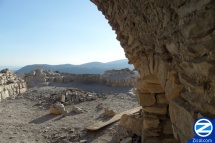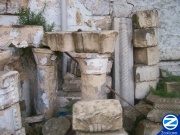Safed 1759 Earthquake
 | |
| Hebrew: | |
|---|---|
| רעידת האדמה בצפת של שנת 1759 | |
| Description: | |
| Destruction and after-effects of the 1759 earthquake in Tzfat. |
The 1759 Earthquake ripped through Northern Israel devastating Safed amongst other cities. Over 200 homes were destroyed and 140 Jews were killed. Following the earthquake most Jews left Tzfat, leaving only 50 families. Out of all the city's synagogues only the Alsheich synagogue and part of the Abuhav Synagogue remained standing. Already in a steady decline from its Golden Age, the destruction wrought by the 1759 earthquake cemented Tzfat’s fall as a center of Jewish life in Israel. Some Rabbis saw the earthquake as retribution for Tzfat's attempts to override Yerushalaim as the central Israeli settlement.
Contents |
[edit] Population
A 1730 census counted 1800 Jews living in Tzfat. A small wool textile trade existed in the city and some of the residents made their living from light trade. The population consisted mainly of Sepharadi Jews whose origins were from Mediterranean countries including Spain, Italy, Portugal, Turkey and Greece.
[edit] Earthquake
The epicenter of the 1759 earthquake was the Beeka Valley in Lebanon, but Tzfat was severely affected. The earthquake triggered a landslide which accounted for much of the destruction in the city built on the slope of a mountain. Two hundred homes were destroyed in the earthquake and 140 Jews were killed. Some people blamed the earthquake on Tzfat's attempt to override Yerushalaim as the central Jewish settlement in Eretz Yisroel.
[edit] Synagogues
All of the existing synagogues were destroyed in the earthquake except for the Alsheich synagogue whose structure withstood the quake.
[edit] Abuhav Synagogue
Some historians believe that the original Abuhav synagogue was built in the 15th century near the base of the mountain, above the cemetery and was rebuilt in its present site, on Abuhav Street after the 1759 earthquake. Others say the original synagogue existed in its present site and was rebuilt in the same location after the earthquake. Both versions relate that the southern wall which held the Ark of the Torah scrolls did not collapse after the 1759 earthquake.One of the Torah scrolls in the Ark had been written in the 15th century by Rabbi Yitzchak Abuhav. According to Safed legend, Rabbi Abuhav warned that the Torah scroll was not be removed from the Ark other than ritual Torah-reading times. After the 1759 earthquake, ten men immersed in a mikva -- ritual bath -- so as to remove the Torah scroll and place it in a safe place as the synagogue was rebuilt. They succeeded in moving the scroll to safer quarters but within a year, all ten men died.
![]() Read full Zissil article on the Abuhav Synagogue
Read full Zissil article on the Abuhav Synagogue
[edit] Aftermath
Following the earthquake most of the Jews left Tzfat, leaving only approximately 50 families. Early Hassidic immigrants who began to arrive in 1764 assisted with reconstruction efforts. Some synagogues were rebuilt after the earthquake but others were only rebuilt after the 1837 earthquake when a major donor, Yitzhak Guetta, financed the reconstruction of Tzfat’s great synagogues.
| ||||||||||||||


